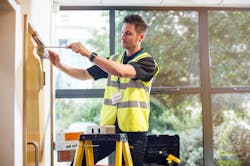Whether surface-mounted or concealed within the frame of a fire door, door closers play an integral role in a building’s operational safety.
Described as mechanically or electronically controlled closing devices, door closers are designed to open a door safely and close slowly but firmly enough to latch into place. When door closers work as intended, this enables a user to operate a door in a way that doesn’t harm themselves or damage the building. More important, a working door closer will keep fire doors closed in the event of a fire, thus aiding in the compartmentalization of fire and smoke.
Aside from using noncompliant hardware, problems appear when a door closer isn’t adjusted correctly. Whether a door is opened manually, mechanically or electronically, an incorrectly adjusted door closer can allow doors to slam open and shut and, in some cases, fail to close completely. This compromises fire safety and building security, but these problems can be fixed.
Door closers operate by using spring tension, controlled by hydraulic fluid that passes from one section to the next as a door is opened. As the spring pushes the door closed again, the fluid passes back to the previous section through a series of valves that control the speed of the mechanism. The valves can be adjusted at the installation stage or at regular maintenance periods and assist in controlling the speed of the door operation.
Adjustments Explained
When it comes to adjusting a door closer, it’s important to understand what type of correction the closer requires to operate in its desired way. Most adjustments can be implemented by opening and closing the various hydraulic valves found on the body of the door closer — turning them by using an allen key or screwdriver to increase or decrease until the door closes in a safe and controlled manner.
Adjustable Closer Speed
In the first instance, if a door closes with too little or too much speed, users are in danger of leaving the door ajar or, when slamming shut, damaging the surrounding walls or the door and hardware itself. This can lead to fire-safety concerns and increased maintenance periods. With this in mind, it’s recommended to locate and adjust the valves so the fire door closes within a 5–7 second period from a 90-degree angle.
Adjustable Latch Action
At it’s most crucial stage of the closing cycle, a door often must overcome seals and latches to close effectively. An unlatched door can facilitate the spread of smoke and fire and renders a fire door useless. Adjustable latch action allows you to control the speed of the door in the final 15 degrees of the closing cycle, which ensures the door closes and isn’t left unlatched. In the event a door closes too violently at the final stage, a closer can be adjusted to soften the final 15 degrees, which helps to avoid damage to the lock strike and frame.
Adjustable Backcheck
In some cases, a fire door might open too quickly and violently, and when poorly adjusted, this can leave the door to jam on the closing cycle. To prevent damage to the door or injury to people who stand behind the door, it’s recommended to adjust the backcheck. Doing so will provide a cushioning effect, which slows the door and is optimal for active building environments, such as schools. Even after you adjust the closer, it’s always worth using doorstops.
Adjustable Delayed Action
A prolonged closing action is useful for busy environments, such as schools, hospitals and care homes. By adjusting the delayed action, the speed at which the door closes can be slowed, which gives people extra time to pass through the doorway. Adjustable timing is set between 70 degrees and 120 degrees. However, a fire door should take no longer than 25 seconds to complete its closing cycle.
Adjustable Hold-open
Although mechanical hold-open door closers are for use on nonfire doors only, electromagnetic doors can implement hold-open door closers under fire-safety standards.
A fully functional fire door closer is a prerequisite for comprehensive fire safety. So, when it comes to the installation and maintenance of fire-door closers, it’s never right to risk building safety or noncompliance.
The first step is to understand where fire safety might be compromised and what door closer adjustments are required to remedy those issues. Only when a closer operates at optimal speed and strength is when a fire door is able to provide essential protection.
Kirk Smith is business development manager at Allegion UK, a division of Allegion.
About the Author
Kirk Smith
Kirk Smith is business development manager at Allegion UK, a division of Allegion.
